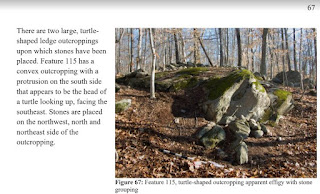From:
Historic Survey and Inventory of Stone Features Located Within the
Manitou Hassannash Preserve, Hopkinton, RI. Submitted to the Town of Hopkinton,
July 2020.
Martin, Alexandra; Eva Gibavic, Kenneth Leonard, and Richard Prescott.
https://www.clresearch.org/past-projects
“Stone rows, enclosures, structures and chambers can be found in the landscapes of Massachusetts and Rhode Island. Structures similar to those shown in the cover photo are documented elsewhere. The age, cultural affiliation, and purpose of these stone structures--which are found in a variety of forms, such as piles arranged in spatial configurations across landscapes, shapes suggesting animal effigies, platforms and chambers--have been the subject of much debate. Some have argued they are remnants of colonial agricultural and storage practices; others that they are prehistoric Native American ceremonial structures. Ascertaining the time periods of their creation had previously been impossible. We felt that optically stimulated luminescence (OSL) had the potential to provide meaningful insights into their origins. In June 2018, samples for luminescence dating were taken from three sites: the Pratt Hill Site near Upton, located in south central Massachusetts; the Tolba Site of Leverett, located in western Massachusetts; and the Site of Hopkinton, Rhode Island. These samples were taken from hand-dug pits beneath stone structures to depths past modern soils into the geomorphic feature upon which the stones were placed (i.e. alluvial fan or terrace). The object of this excavation was to date the placement time of the stones onto the geomorphic feature...
...The age of the sample from the Site of Hopkinton, Rhode Island is in the range of 1570-1490 C.E (or 490 plus or minus 40 years ago).”











No comments:
Post a Comment